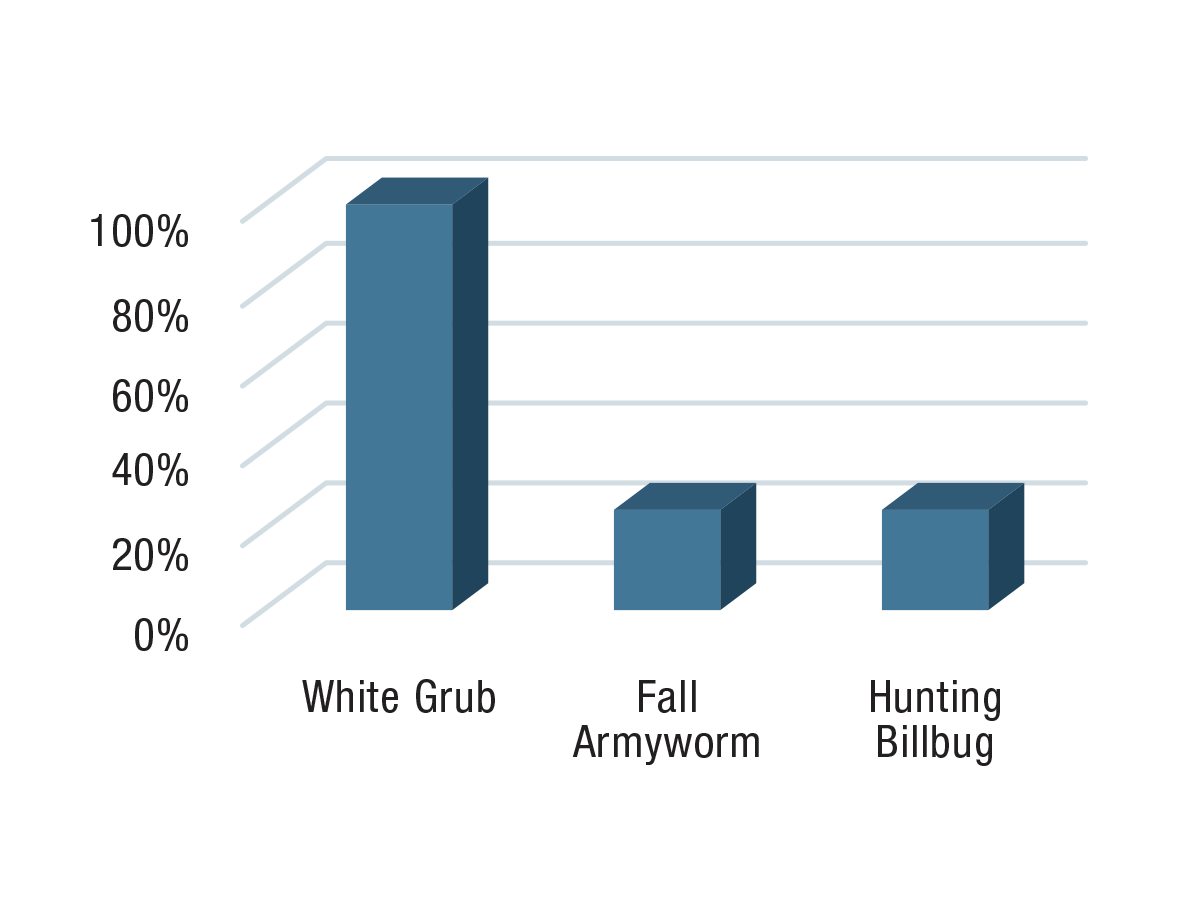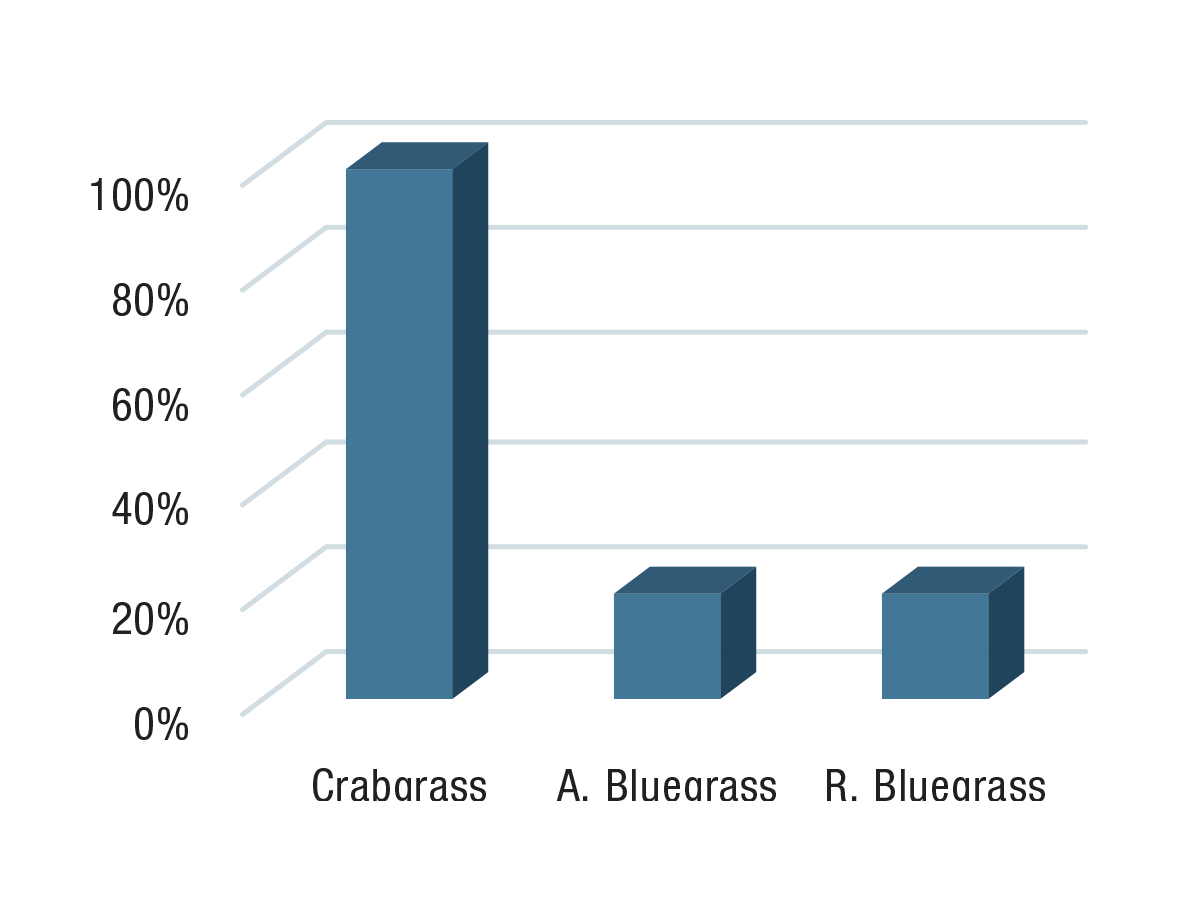
5 minute read
Cover Story
Major Pests and Control Programs for the MD Turfgrass Industry in 2023, Part 3: Sod Producers
By Dr. Kevin Mathias
A phone survey was conducted in the fall of 2023 to determine the key turfgrass pests within the turfgrass industry. The survey asked turfgrass professionals what their major pest problems were within the areas of insect, weed, and disease problems and what type of control programs were used. The following article covers the major pest problems and control actions taken by sod producers in Maryland.
Sod Production
The major sod crop consists of a tall fescue (90%) and Kentucky bluegrass (10%) mixture in Maryland with lower acreage dedicated to the warm season turfgrasses Zoysiagrass and bermudagrass and the cool season turfgrasses Kentucky bluegrass and hybrid Kentucky bluegrass. Total acreage of sod is 8,000 acres based on the Maryland Economic Impact report in 2005.
MAJOR PEST PROBLEMS
Insect Pests
The insect pests mentioned were white grubs, fall armyworm, and hunting billbug. White grubs were considered a key pest and were treated preventatively. Since the survey included pest problems from the previous three years, the fall armyworm outbreak of 2021, which caused wide spread damage to turf in Maryland and other parts of the country, was mentioned as a pest problem. Hunting billbug was associated with Zoysiagrass production.


The insecticides used to control insect pests in sod fields were imidacloprid products, Acelepryn (chlorantraniprole), Sevin (carbaryl), and bifenthrin based products. The major preventative white grub control insecticide was imidacloprid followed by Acelepryn. The difference in use patterns is due to the lower cost of imidacloprid-based insecticides. In smaller acreage fields such as Kentucky bluegrass, Acelepryn was often used not only for white grub control but also for leaf feeding caterpillars such as fall armyworm, sod webworms, and cutworms. The insecticide Sevin was used as a rescue treatment for white grubs and for any surface feeding insect. Bifenthrin based products were used for surface feeding insects.

Weed Pests in Tall Fescue / Kentucky Bluegrass Sod Fields
The major or key weed pests can be divided into two main groups; the grassy weeds and the broadleaf weed group. Within the grassy weed group, summer annual grasses such as crabgrass were considered key pests. Two other grassy weeds mentioned were annual bluegrass and rough bluegrass that were present in smaller amounts in sod fields. What is of interest in sod production systems is a mesotrione product (Tenacity) used in the fall at seeding to address both future summer annual grasses and several broadleaf weeds present in the fall at seeding. Spot treatment or a rescue treatment with either Acclaim (fenoxaprop) or Drive (quinclorac) would be performed in late spring or early summer if any summer annual grasses were present in a field that would be harvested in the immediate future.
White clover was the key broadleaf weed mentioned in sod production fields. Oxalis and dandelion were the other two minor weeds mentioned in this survey. The herbicides listed for broadleaf weed control included phenoxy based herbicides used in combination such as 2,4-D and mecoprop or as a threeway combination of 2,4-D, mecoprop, and dicamba. For more difficult to control weeds such as oxalis, triclopyr was often used. The use of these broadleaf weed control herbicides was often applied on an as-needed basis.


Disease Pests
Since a majority of sod production fields consist of a tall fescue/Kentucky bluegrass mixture, the key disease pest was brown patch with 100% of sod producers indicating brown patch as a key disease. Also, a preventative fungicide program was implemented for controlling brown patch in sod fields that would be harvested in the current growing season. Other diseases that were mentioned were dollar spot and red thread in tall fescue fields, summer patch in Kentucky bluegrass fields, and large patch or Zoysia patch in zoysiagrass fields.
The preventative fungicide schedule used for brown patch and other minor diseases which consisted of monthly applications from May through August would often consist of fungicides in the DMI chemistry such as Banner Max (propiconazole) and the strobilurin chemistry such as Heritage (azoxystrobin). Also, chlorothalonil based fungicides were used.

Summary
Sod producers will grow high performing species and turfgrass cultivars that have been screened for their pest tolerances and overall survivability in the Maryland growing environment. Also, the goal of a sod producer growing a tall fescueKentucky bluegrass crop is to harvest that crop within a year and that the crop needs to be free of major pest problems whether that be a weed, insect or disease pest. The marketability of that sod crop is based on turfgrass density, color and overall uniformity of the stand. Therefore, preventative pest control programs are implemented to ensure both marketability and availability of that crop to the sod consumer.




